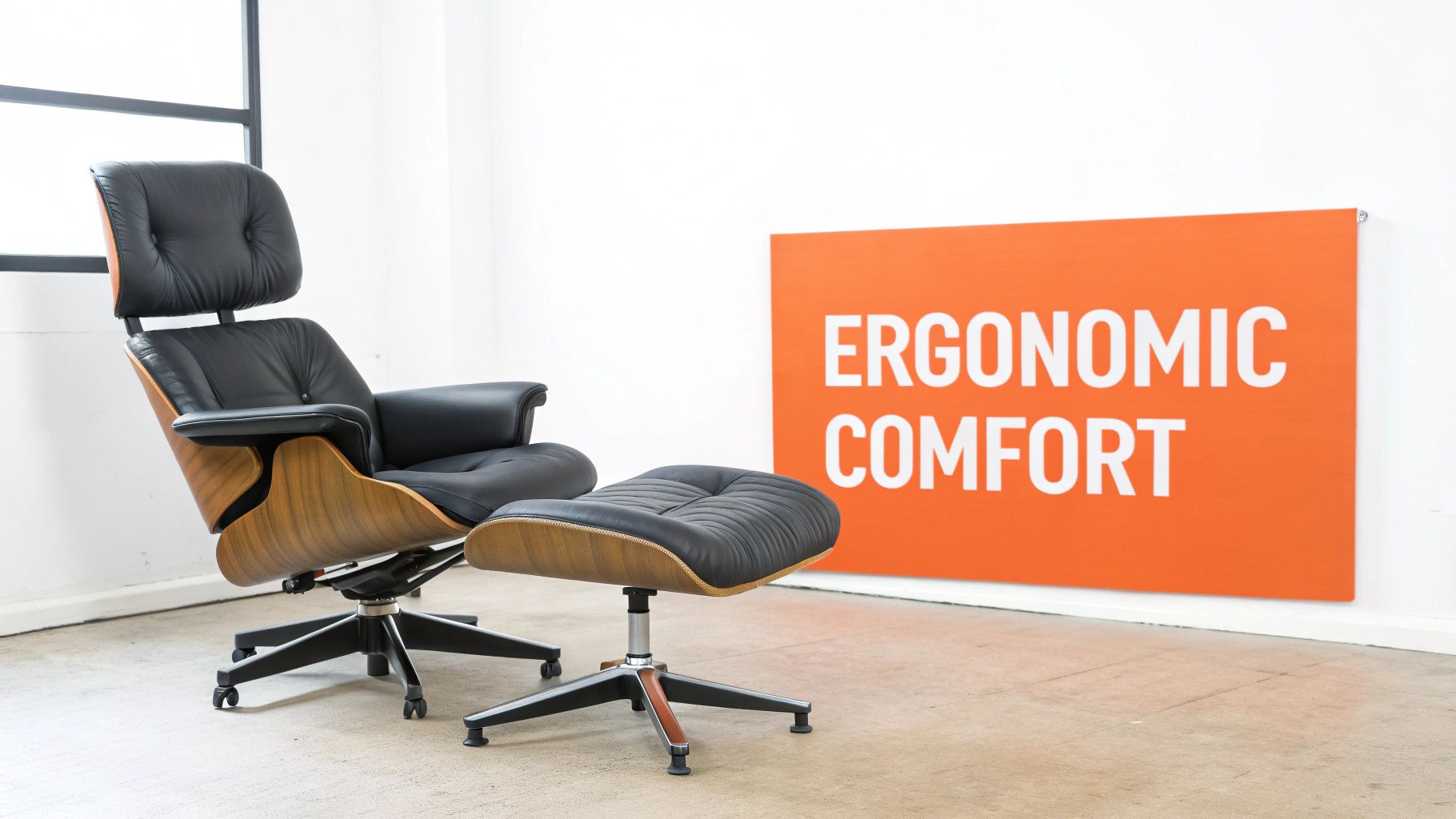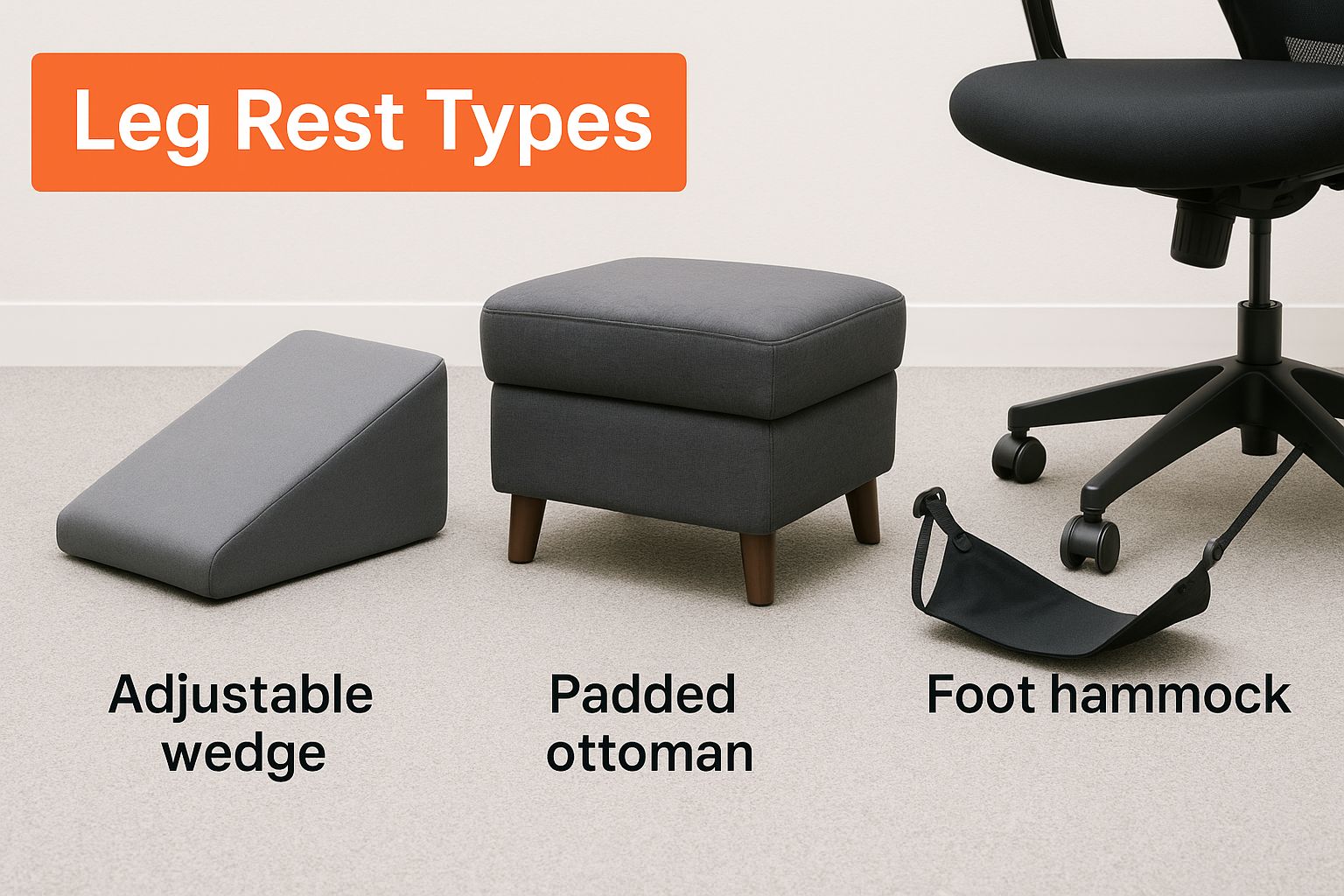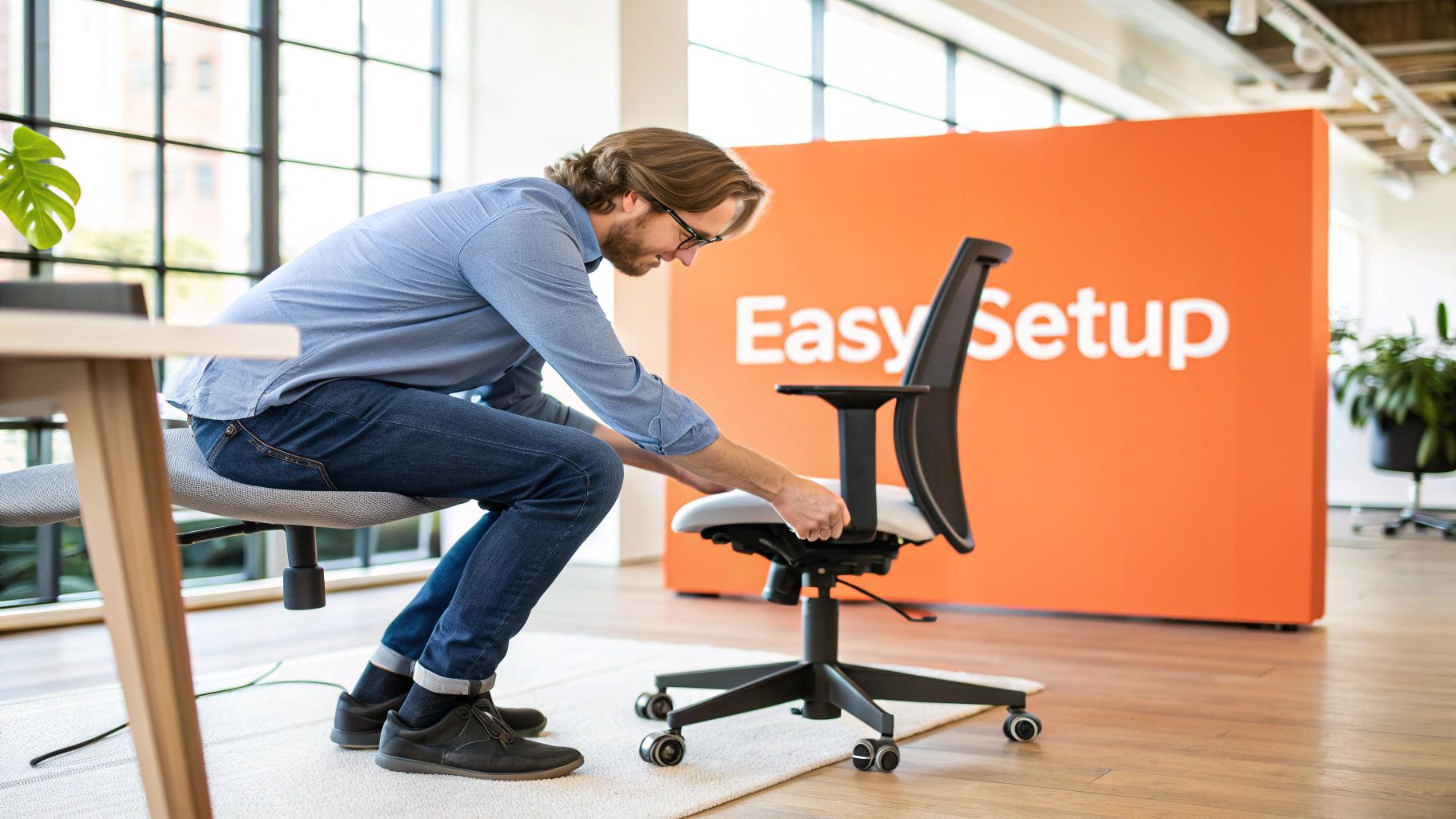If you've ever felt that nagging ache or heaviness in your legs after a long day at your desk, you're not alone. It's a common side effect of modern office life, but it's not something you have to just put up with. A leg rest for your office chair might sound like a luxury, but it's one of the most practical ergonomic tools you can add to your setup. It's designed to do one simple thing: elevate your legs to take the strain off your body.
Think of it less as a footstool and more as a crucial part of a truly supportive workspace. By lifting your legs, you're actively improving circulation, easing pressure on your lower back, and fighting off that end-of-day fatigue before it even starts.
Why Your Legs Need Better Support at Work
Spending hours at a desk means your legs often bear the brunt of the inactivity, even when you don't consciously realise it. That prolonged sitting can quietly lead to aches, stiffness, and more serious long-term health issues. Adding a leg rest to your office chair is a straightforward change that can transform your workspace from merely tolerable to genuinely comfortable and supportive.

Here's a simple way to picture it: imagine your circulatory system is like a garden hose. When you sit for hours on end, especially with your feet planted flat on the floor or left dangling, you're essentially putting a 'kink' in that hose. This restricts blood flow, causing that all-too-familiar heavy, tired sensation in your legs.
The True Cost of Poor Ergonomics
Brushing off lower body support as a minor issue is a mistake; the health implications can be quite significant. Here in Australia, there's a growing understanding of occupational health and the risks that come with sedentary jobs. Poor posture and a lack of proper leg support are major culprits behind musculoskeletal disorders (MSDs), which account for around 30% of all workers' compensation claims each year.
What's more, a national survey found that 68% of Australian office workers suffer from discomfort directly related to their chair. This statistic really shines a light on the need for better ergonomic solutions. A chair with good leg support helps distribute your weight more evenly, improves your posture, and can even lower the risk of serious conditions like deep vein thrombosis (DVT). You can read more about how ergonomics is reshaping the office furniture market.
By elevating your legs, you instantly take the pressure off. This simple adjustment improves blood flow and lays the groundwork for a healthier, more comfortable, and focused workday. It’s a core element of any modern, health-conscious workspace.
Investing in a high-quality ergonomic chair that has these features built-in is often the most effective way to go. For instance, the Pago chair range includes some fantastic options, many of which are easy to find at major retailers like Officeworks. This small change can turn your chair from just a place to sit into a genuine tool for better health and wellbeing.
Choosing Your Perfect Type of Leg Rest
Finding the right leg rest for your office chair isn’t a one-size-fits-all deal. What works wonders for your colleague in a spacious corner office might not suit your compact home setup. The best choice really boils down to your workspace, your existing chair, and what feels most comfortable for you.
Let’s break down the main options out there. There are essentially three styles to consider, and your decision will likely hinge on convenience, space, and whether you prefer a built-in solution or a separate, more flexible accessory.
This image gives a great visual overview of some of the most common types you'll come across.

As you can see, the options range from structured wedges to plush ottomans and even clever under-desk hammocks, each tailored for different ergonomic goals.
Integrated and Retractable Leg Rests
If you’re after the ultimate in convenience and a clean, minimalist look, nothing beats an integrated leg rest. These are built right into the chair, designed to slide or fold away neatly under the seat when you don't need them. It's a truly seamless design.
The beauty of this style is that your leg rest is always there, perfectly positioned and ready to deploy. You don't have to worry about tripping over an extra piece of furniture or finding a place to store it. This makes it a fantastic choice for smaller home offices or any workspace where keeping aisles clear and uncluttered is a priority.
Standalone Footrests and Ottomans
What if you already have an office chair you love but just want to add some leg support? A standalone ottoman or an adjustable footrest is your most versatile bet. These are completely separate pieces of furniture, so you can place them exactly where they feel best.
You'll find them in a huge variety of materials and styles. You could go for a plush, padded ottoman for a touch of luxury, or a more functional plastic or metal model that lets you fine-tune the angle for precise ergonomic support.
The real superpower of this option is its universal compatibility. A standalone rest works with virtually any chair, giving you total freedom to mix and match. Plus, you can easily move it to use with an armchair in the living room when you’re off the clock.
Attachable Leg Rests
The third route is an attachable leg rest. Think of this as a middle-ground option—it's an accessory you add to your existing chair, usually by clamping it onto the gas lift cylinder. This gives you a more integrated feel than a separate ottoman without needing to buy a whole new chair.
However, compatibility can be tricky. You have to be absolutely sure the attachment mechanism will fit your specific chair model securely. While they can be a great upgrade, they sometimes don't offer the same rock-solid stability or smooth operation as a chair designed with a built-in rest from the start.
If you're weighing the pros and cons, our guide to choosing a footrest for your office chair has some extra pointers that can help you make the right call.
To help you visualise the options, here's a quick comparison of the different leg rest solutions we've just covered.
Comparing Different Leg Rest Solutions
Each type has its place, and the best one for you depends entirely on what you value most—be it seamless integration, flexibility, or a budget-friendly upgrade.
Unpacking the Health and Productivity Perks
Adding a leg rest to your office chair is more than just a creature comfort; it's a smart move for your health that genuinely boosts your productivity. Don't think of it as a luxury, but as a practical tool that helps you perform at your best. By simply elevating your legs, you’re making a small change that can have a surprisingly big impact on how you feel at the end of the day.

This simple adjustment improves your circulation. That means less of that familiar swelling, heaviness, and general discomfort that tends to build up after hours of sitting still. Better blood flow not only lowers the risk of developing problems like varicose veins but also keeps your legs feeling much fresher and more energised.
Supporting Your Spine and Sharpening Your Focus
You might be surprised to learn there’s a direct link between supporting your legs and looking after your lower back. When your legs are properly elevated, it gently tilts your pelvis into a healthier, more natural alignment. This helps maintain the gentle curve of your spine, taking a significant amount of strain off your lumbar region.
This physical relief has a knock-on effect on your mental clarity. When your body isn't nagging you with aches and pains, you’re far less distracted. This frees you up to stay focused, feel more switched on, and remain productive for much longer stretches. You can dive deeper into the wide-ranging benefits of ergonomic office furniture in our detailed guide.
An investment in ergonomics is an investment in your performance. A leg rest is a perfect example of a small tweak that delivers a huge return in both comfort and concentration.
The push for better wellness at work has fuelled massive growth in Australia's office furniture market. It was valued at around USD 2.45 billion and is expected to climb to USD 3.03 billion by 2030. This trend shows a clear shift towards ergonomic solutions that put employee health first, with features like leg rests becoming a common expectation rather than a rarity.
Ultimately, choosing a supportive chair like a Pago chair, available at Officeworks, that includes a good leg rest is a strategic decision for both your long-term health and your daily output.
How to Set Up Your Leg Rest for Optimal Comfort
Getting the most out of your leg rest isn’t about propping your feet up as high as they can go. It’s all about finding that sweet spot. The real goal is to create a gentle, comfortable slope from your hips down to your knees, ensuring your lower legs and feet are fully supported.
Think of it like adjusting the driver's seat in your car. A few small tweaks can be the difference between a comfortable trip and an achy back. When you get the positioning right, you’re actively helping your circulation, not accidentally working against it.
Finding the Perfect Position
First things first, sit all the way back in your chair so your back is firmly against the backrest. Now, extend the leg rest and place your legs on it. You’re looking for a height that puts your knees just a fraction lower than your hips, creating that subtle downward angle.
This is often called a “waterfall” posture, and for good reason. It helps take the pressure off your sciatic nerve and eases the load on your lower back. Your calves should feel nicely cushioned, with no digging or sharp pressure points behind your knees.
One of the most common mistakes is cranking the leg rest up too high. This can overextend your knees and actually restrict blood flow – the very problem you’re trying to solve. Your legs should feel relaxed and naturally supported, not forced into an awkward position.
Adjusting Height and Angle
The secret to ergonomic bliss lies in how your leg rest works with your chair. It’s a team effort. Here’s a simple way to get it right:
- Adjust Your Chair First: Before you even think about the leg rest, make sure your chair height is correct. Your feet should be flat on the floor with your knees bent at roughly a 90-degree angle.
- Position the Leg Rest: Now, bring out the leg rest. Adjust its height so it meets your calves and provides comfortable support. You shouldn’t have to stretch or strain to keep your legs on it.
- Check the Angle: Make sure there isn’t a gap between your legs and the rest. The support should feel continuous from just behind your knees down towards your ankles.
Fine-tuning your setup is what turns a good chair into a great one. For a deeper look into creating a truly supportive workspace, you can get more information on mastering your workstation ergonomics. Taking a holistic view of your desk and chair ensures you’re getting the maximum health and comfort benefits every single day.
Why Sustainable Furniture Choices Matter
When you're picking out office furniture, especially something as important as your chair and a leg rest, your decision has an impact that goes well beyond your own comfort. In today's world, sustainability isn't just a trendy idea; it’s a fundamental part of making smart, responsible purchases. It's about shifting our mindset from "buy cheap, replace often" to valuing things that are built to last.
Choosing a durable, high-quality product like a well-made ergonomic chair is a sustainable choice in itself. Let's be honest, those cheaper, flimsy alternatives often break down and end up in a landfill within a year or two, just adding to our waste problem. A thoughtfully designed chair, on the other hand, is an investment that can serve you well for many years, dramatically shrinking its environmental footprint over time.
Conscious Choices for a Healthier Planet
Making an eco-friendly choice means looking at the bigger picture. Where did the materials come from? How was it made? And what happens to it when you're done with it? Here in Australia, for instance, the office furniture market is paying a lot more attention to sustainability, and for good reason.
This shift is a direct response to some pretty sobering statistics, like the 8.5 million tonnes of furniture waste Australia produces every single year. Because of this, we're seeing a growing demand for furniture with green credentials, made from recycled or responsibly sourced materials. Investing in a quality piece means you're not just looking after your own health, but you're also making a commitment to the planet.
Choosing furniture built to last is one of the most effective ways to reduce waste. It moves us away from a disposable culture towards one that values craftsmanship, durability, and long-term value for both the user and the environment.
A premium chair from a trusted brand like Pago, available at Officeworks, really captures this idea. It’s designed not just for great ergonomic support but for a long, productive life, making it a genuinely smart choice.
If you're interested in learning more about how to bring these principles into your workspace, have a look at our guide on sustainable office solutions.
Frequently Asked Questions
When you start looking into ergonomic gear, it's normal to have a few questions pop up. Let's clear up some of the common ones about office chair leg rests so you can make a confident choice.
Can I Add a Leg Rest to Any Office Chair?
It's a bit of a gamble. While there are some "universal" add-on leg rests out there, you can't assume they'll fit your chair. You really have to check the product specs to make sure it will connect securely to your chair's specific design and base.
For a solution that just works, without any guesswork, your best bet is often an ergonomic chair with a built-in leg rest, like a Pago chair available from Officeworks. Another great option is a separate ottoman, which will work with literally any chair you have.
Is It Good to Sit with My Legs Up All Day?
Definitely not. The real secret to good ergonomics is movement. A leg rest is brilliant for taking the pressure off and getting your circulation going, but it's meant for short periods, not the entire workday.
The aim is to change up your posture. Alternate between having your legs elevated and keeping your feet planted flat on the floor. The best advice is to listen to your body and move around whenever you feel the need.
Will a Leg Rest Really Help My Back Pain?
For many people, the answer is a resounding yes. When you elevate your legs, you take a significant amount of strain off your lower back. This simple change encourages a healthier spinal curve, which can make a real difference in easing pain and discomfort.
But remember, a leg rest is just one piece of the puzzle. To get the most out of it, you need a complete ergonomic setup: a supportive chair with great lumbar support and a desk set to the right height.
To make sure every part of your workspace supports you properly, check out our guide on how to choose an office chair. It’s full of practical tips for creating a truly comfortable setup.
What Is the Difference Between a Footrest and a Leg Rest?
This is a common mix-up! They look similar but do very different jobs.
- A footrest is basically a small platform that sits on the floor. Its main job is to support your feet. It's a lifesaver if you're on the shorter side and your feet don't quite reach the floor, helping you get that ideal 90-degree knee angle.
- A leg rest, on the other hand, is designed to support your entire lower leg—from the knee down to your ankle—in a raised position. This gives you much more comprehensive relief, boosting circulation and easing pressure on your thighs and spine.
A simple way to think about it is that a footrest corrects your posture from the ground up, whereas a leg rest provides total lower-body relaxation.
At Pago International, we believe comfort and support are the cornerstones of a productive day. Explore our collection of ergonomic chairs to find the perfect solution for your workspace.Discover the Pago Chair range today.


